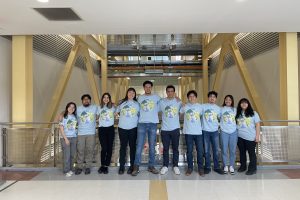
A team led by Civil and Systems Engineering (CaSE) students Ari Harris-Kupfer ‘24 and Wendy Holguin ‘26 came in fourth place in the Mid-Atlantic East division of the 2024 Student Steel Bridge Competition, held at the University of Maryland College Park on April 6 and 7. Sponsored by the American Society of Civil Engineers (ASCE) and the American Institute of Steel Construction (AISC), the competition is a premiere annual event for civil engineering students, challenging teams to design, fabricate, and erect scale-model steel bridges. The CaSE team competed with students from six other universities throughout Maryland and Pennsylvania.
Each year, the competition challenges students to design and build a bridge onsite for a hypothetical scenario. This year, teams were tasked with designing a model bridge that—if built in reality— would provide access over a man-made river for a proposed new disc golf course in Lincoln Parish Park in Ruston, Louisiana. The teams had to devise creative solutions to design and build a 20-foot-long bridge to support a load of 2,500 pounds, while providing aesthetic appeal and adhering to strict design and construction specifications.
“Our goal was not just to build a bridge, but to engineer a solution that would meet the needs of users while blending seamlessly with the park’s natural elements,” said Harris-Kupfer. “We knew we would face tough competition, so we were very intentional with every detail, from design to construction.”
The team’s steel bridge journey began with an intersession course focusing on structural design principles, followed by several months of designing, planning, and building. January and February were used to finalize their design. In March, they sent their design to B&B Welding, a local steel fabricator, for production. After receiving the bridge, the team met for practice sessions to refine the construction process and ensure they could assemble their bridge onsite within the 45-minute competition time limit. This was when the students refined their construction approach, using power tools and easy-access toolbelts and color-coding the steel pieces to expedite material selection during construction.
“We had to work like a well-oiled machine, with each member playing a crucial role,” said Holguin. “It was intense, but incredibly rewarding to see the result of our efforts from the past few months.”
At the competition, CaSE team members watched nervously as their bridge was load tested to assess structural integrity. Criteria for scoring included load-bearing capacity, lateral load capacity, bridge weight, and aesthetic appeal. The bridge weighed 300.4 pounds and was able to withstand 2,425 pounds of load-bearing weight and 50 pounds of lateral load.
Their completed bridge garnered accolades for its aesthetic appeal and lightweight construction, earning second place in aesthetics and third place for lightness.
“Taking part in my first steel bridge competition was an incredible learning experience. I’m excited to use what I’ve learned and be able to apply that to next year’s competition,” said team member Athena Zapantis ’27.
Additional CaSE team members included Abigail Aranda-Lopez ‘26, Tayo Ilunga-Reed ‘25, Emely Pacheco ‘26, and Madison Villarba ‘27. Cas Caswell, a department alumnus and structural engineer for Walter P Moore, advised the team, which also had members from the Whiting School of Engineering’s departments of Environmental Health and Engineering and Mechanical Engineering, and the Krieger School of Arts and Sciences’ Department of Psychology.
First place winners from the 20 regional competitions will go on to compete in the national finals held at Louisiana Tech University on May 31-June 1.